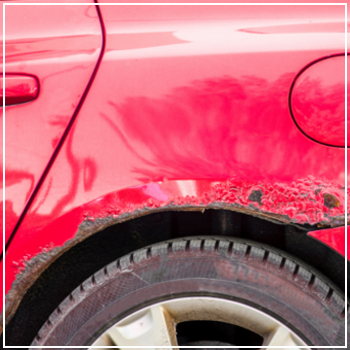Rust forms when metal undergoes a chemical reaction with water or salt, leading to oxidation. This is why cars parked outside in humid coastal environments often show signs of rust first. Conversely, vehicles driven on roads covered with salt during colder seasons usually experience significant rusting on the undercarriage. Even a small patch of rust can quickly spread, often beneath the paint layer. Signs like bubbling or peeling paint can indicate that your car’s metal is beginning to corrode. A minor scratch or dent can provide an entry point for rust, particularly if your car is frequently exposed to rain or kept near bodies of water. Instead of waiting until rust has formed and trying to scrape it off, take proactive steps to prevent it from happening in the first place. Here are some effective methods to help keep your car rust-free. There are several ways to protect your car against rust depending on its severity: These coatings not only reduce the depth of scratches and dents but also allow water to bead off easily. They also protect against tree sap and bird droppings, which can eat through paint and contribute to rusting. By blocking or minimizing these harmful elements, you significantly lower the risk of rust forming. How often do you wash your car during the winter? After driving on salted roads, your vehicle can accumulate corrosive debris that sticks around unless washed promptly. Over time, this buildup eats away at your car’s undercarriage and trim. Regular washing, especially after snowfall, is essential. If you live close to the ocean, plan regular washes followed by a wax treatment. This not only removes salt but also cleans bird droppings, tree sap, and dirt that can weaken your car’s paint job, accelerating rust formation. During autumn, drain plugs often collect leaves, dirt, and moisture, which can lead to rust. Clear out any debris from around the edges of the hood, trunk, and door bottoms to prevent rusting. If you’re unsure where the plugs are located, consult your car manual or seek advice from a mechanic. Spilling a drink inside your car isn’t just about stains—it can seep into the upholstery and cause moisture buildup beneath. This trapped moisture often leads to rust patches spreading across your car’s underside. After a spill, use a highly absorbent microfiber towel to soak up as much liquid as possible. If the spill persists, remove floor mats to dry them outside the car. For carpets that can't be removed, park the car in a well-ventilated area to air dry. Regular inspections can catch rust before it spreads and causes major damage. Look for bubbling or raised areas on the paint surface. Focus on common rust spots such as windows, wheel wells, fenders, drain holes, undercarriage, and places where body panels meet. If equipped with the right tools, remove the tires to check hard-to-reach areas for rust. If you live in a damp, snowy, or coastal area, storing your car indoors can make a big difference. A garage without excess moisture is ideal, but even a covered carport can help shield your vehicle from harmful elements. For peace of mind, schedule an appointment with DaSilva’s Auto Body to rustproof your car or address existing corrosion before it worsens. Contact their Naugatuck location today to learn more about their services. By taking these preventive measures, you can significantly extend your car’s lifespan and keep it looking great for years to come. LW300FN LW500FN LW600FN LW1200FN ZL50 wheel loader is an upgrade model released by XCMG on the basis of the classic 3T-level loader, featuring higher quality reliability, more economic operations, and better operation comfort.LW300FN is the most popular model of China 3t wheel loader With the features of maturity and reliability of the old model, LW300FN is improved all round, and leads in the same kind of product. Xuzhou Xuqi Heavy Machinery Co., Ltd. , https://www.xqheavy.com Seeing premature rust on your car is one of the most frustrating things for any vehicle owner. While weather and age-related wear are unavoidable, finding rust spots on a relatively new car can feel like a punch in the gut. Before you're left dealing with this problem, it's important to understand why your car might be rusting prematurely.
Seeing premature rust on your car is one of the most frustrating things for any vehicle owner. While weather and age-related wear are unavoidable, finding rust spots on a relatively new car can feel like a punch in the gut. Before you're left dealing with this problem, it's important to understand why your car might be rusting prematurely.Understanding How Rust Forms
1. Rustproofing Beforehand
2. Regular Washing
3. Pay Attention to Drain Plugs
4. Address Spills Promptly
5. Inspect and Treat Rust Early
6. Keep Your Car Indoors
Performance Highlights:
Outstanding capability, with traction at ≥9t and breakout force at ≥13t.
High adaptability, with turning radius at 5, 165mm (tire center).
Market position:
Industry 3t single-model sales champion.
Excellent quality power and drive systems.
High maturity and reliability:
The 2600mm wheelbase features high mobility and flexibility and is applicable to all kinds of working sites.
The bucket is made of high strength material to realize high wear and impact resistance.
Optimized bucket shape:
The lengthened bucket bottom and the sharp bucket shape ease the penetration and realize higher bucket loading capacity.
The contracted flare angle and the reduced cross section ease penetration and lifting.
1. Standard bucket: Suitable for diversified working conditions.
2. Rock bucket: It's dedicated for handing of hard materials (such as rock), featuring good resistance against wear and impact.
3. Coal bucket: It's dedicated for handling of bulk materials (such as coal), featuring high bucket capacity and high efficiency.
4. Clamp: For grab and transport of various woods and tubing.
5. Bale grabber: It's used for the grabbing and handling of various light materials in farms, biological power plants, and paper mills.
6 Strategies to Prevent Car Rust
